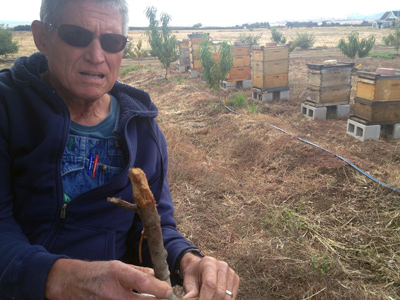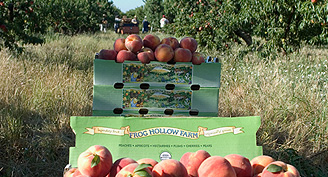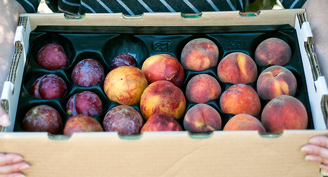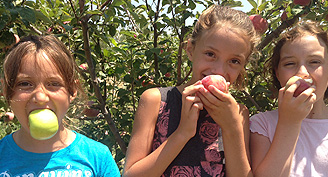Gopher Damage and This Week’s Varieties
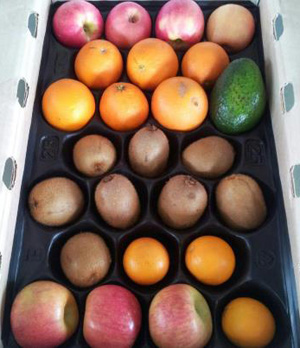
This Week’s Fruit
Hass Avocados
Stehly Farms Organics, Valley Center, CA
Creamy in texture, nutty in flavor, with a small to medium seed. The Hass skin is easy to peel and darkens from green to purplish-black as it ripens. You can tell it is ripe by the color of the skin (dark) and if it yields to pressure.
Pink Lady Apples & Fuji Apples
Cayuma Orchards, New Cayuma, CA
A cross between the Golden Delicious and Lady Williams, the Pink Lady is a crisp and juicy apple with a tart finish. A creamy white colored flesh that resists browning makes this an excellent apple for salads and slicing. Also a modern day favorite for eating out of hand. A cross between the Golden Delicious and Lady Williams, the Pink Lady is a crisp and juicy apple with a tart finish. A creamy white colored flesh that resists browning makes this an excellent apple for salads and slicing. Also a modern day favorite for eating out of hand. Fujis are a cross between Red Delicious and Ralls Janet, an heirloom apple dating back to Thomas Jeffrson. Fujis are loved by many for their crisp, sweet, and juicy character.
Hayward Kiwi
Chiechi Farms, Live Oak, CA
Originally known as the Chinese gooseberry due to its Chinese orgins. Hawyward Wright, a New Zealand nurseryman propagated his plants by grafting and they eventually became the preferred cultivar of growers due to their sweet flavor and thin skin.
Navel Oranges
Olsen Organic Farms, Lindsay, CA
California Navel Oranges are considered to be the best Navels for eating out of hand. They have a thick skin that is easy to peel, are seedless, and have a meaty and sweet flesh that makes them a perfect snack. Navels are also great for juicing and cooking.
Taccoro Blood Oranges
A beautiful orange to deep red flesh is revealed when you slice open a Tarocco. The flesh of the blood orange is firmer and more dense than an orange and its flavor is a little more tart. These beauties sweeten and darken in color as the season progresses.
A Note from Farmer Al
Dear CSA Members,
Ah Spring! The sun is shining, the bees are buzzing, the birds are flying, the trees are in full bloom and underneath their pink and white blossoms there are bright yellow mustard flowers in bright green grass. But, springtime is also the time of year when our greatest nemesis rears its ugly little head, the gopher.
Of all the pests that we have in the orchard, the gopher is by far the worst. Forget the Oriental Fruit Moth, the aphid, peach twig borer; there are effective organic controls for all these pests but for the gopher, there is no one single method of prevention. Left unchecked, they will cause tens of thousands of dollars worth of damage mostly in to the small trees of newly planted orchards and we have to fight it on many fronts, with our human crews and our wildlife crew.
Last year, we planted 300 Suncrest peach trees on a half- acre section of land where we had just removed some older trees. The ground had been ripped with 3 foot steel shanks pulled by a very large D-8 caterpillar tractor, leaving not a single gopher in the ground. We continued to “rip” the ground, then disk and disk again until the soil was light and ready for planting in January of 2012. Now, one year later 28 trees (10% of that planting) have keeled over with no roots left to anchor them in the ground. The cost of the trees and the extra labor to replant has been “chewed up” by gophers. Not to mention a whole production year lost, labor spent in pruning, water irrigated and materials spread.
We have many different ways of getting rid of gophers but there is no single method that works 100% effectively. We have tried trapping which is the most effective, but laborious. We’ve tried smoke bombs which were expensive and labor intensive and not terribly effective either. We’ve even tried a “gopher-blaster”, a torch that looks not unlike flame thrower which is placed down the hole and the gopher is supposed to be frightened of the noise or, well, torched. This doesn’t really work well because the earth absorbs the sound and the heat and in the process it also damages tree roots. Now, we still use traps but, we also send a crew member out into the orchard with a shotgun which so far has proven to be the most productive. The dead gophers are cleaned up by the night crew, coyotes. Our other night crew, the barn owls are responsible for eating one gopher per owl per night. There are also the weasels and of course, the gopher snake. Even our dog Nocci, can be seen obsessively digging in the soil at a perpendicular angle to the ground, digging her snout deep into a hole but, I have yet to see her catch one. They all have to do their share to keep the voracious gopher population under control.
On our farm we always strive to keep things in balance and I’m sure the gopher has its place; I just wish it were somewhere else.


(Farmer Al last Fall examining a tree felled by gophers)


 (Farmer Al last Fall examining a tree felled by gophers)
(Farmer Al last Fall examining a tree felled by gophers) 
